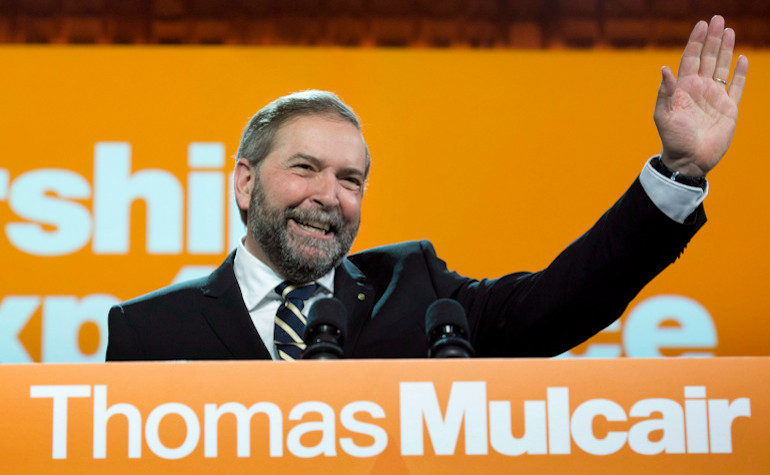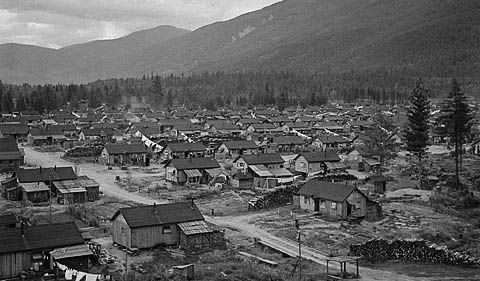The new leader of the Canadian New Democratic Party, Thomas Mulcair, faces big challenges and opportunities as the majority Conservative government continues its cold, neo-liberal agenda.
Mulcair was elected leader of the NDP, and the official opposition in March of this year, after the previous leader, Jack Layton, died suddenly of cancer in August 2011. This was less than 4 months after he led the NDP, Canada’s moderate social democratic party, to its best result ever becoming the official Opposition. The NDP, with Jack Layton as leader, had moderate social democratic policies but he was effective in building the party and criticizing the right wing shift of the Liberals.
In the last federal election in 2011 the Conservatives won a majority government after 5 years of minority rule, with 166 seats and 40% of the vote. The NDP won 103 seats with 31% of the vote. Most significantly the party made a major break through in Quebec, winning the 59 of the 75 seats there. The main losers in Quebec were the Bloc Quebecois, going from 49 seats to 4. The Liberals, the traditional party of government, were reduced to only 34 seats and 19% of the vote across the country.
The election of Thomas Mulcair as new leader of the Canadian New Democratic Party (NDP) may be decisive in determining whether the NDP takes advantage of its historic opportunity to change the country.
The Leadership Contest
Mulcair, an MP from Quebec and the most right-wing of the 4 final candidates for the leadership, won with support of 57% of the votes. He talked about a more central political position for the NDP, while the 3 other candidates all had more progressive platforms, although none offered a clear radical program for change.
Brain Topp, who finished second, was a senior NPD official who had never been an MP. He positioned himself as defending traditional NDP social democratic values and campaigned around tackling the rapidly growing inequality in Canada by raising taxes on the rich and action on climate change – Canada has one of the worst records of inaction on climate change in the world. However his past record was more right wing, exemplified by his time as senior advisor to the Saskatchewan NDP government of the 1990s which cut services and raised taxes on working people to balance the budget.
Nathan Cullen, an MP from BC who finished third, based much of his campaign on a strong defence of the environment – he has been outspoken against the proposed twin pipeline to connect the BC coast to the Alberta tar sands. He also supported electoral reform with proposals for proportional representation (PR) and tax increases on the rich. However, he also argued that in Conservative held seats the joint membership of the New Democrats, Liberal and Green parties should decide on a single candidate. This would blur the differences between the NDP and Liberals offering the Liberals a political lifeline.
Peggy Nash, an MP in Ontario finished fourth. She was seen as the most left-wing and has a background as a union activist. Her platform included PR and a shift to green jobs to protect the environment; however overall her platform was weak. While she did talk of higher taxes on the rich, she did not make it a major issue. Her campaign was not based on clear strong policies; she seemed to think she could gain support based on her past record.
Although Cullen and Nash had more progressive platforms, as each was eliminated in the ballot rounds a sizeable number of their supporters went to Mulcair. This demonstrates that the debates on policy, informed by the candidate’s past track records, were not clearly distinguished by left and right platforms. The NDP over the years has moved towards the political centre, none of the candidates really proposed returning to the radical past of the NDP and its predecessor the CCF.
Mulcair’s victory does not represent a dramatic move to the right; rather it is a continuation of past trends in the NDP. However it is symbolic of that trend and while being a small move it may lead to a fundamental change; small changes can accumulate and lead to a decisive change.
Key Issues for the Future of the NDP
The NDP, as the official opposition for the first time nationally, has a historic opportunity to defeat the Conservatives and form a government that could make a real difference to the lives of Canadians. To do this will require a change from the party’s present direction and dealing with at least 4 key issues:
- Strengthening its base in Quebec
- Decisively defeating the Liberals
- Building an active membership
- Adopting a radical progressive platform
All of these depend on the policies and actions the party takes and Mulcair’s record does not bode well on any of these crucial points.
Mulcair joined the NDP only in 2007. Before then he had been a member of the Cabinet in the Quebec Liberal government. While Environment Minister he bragged about reducing the workforce by 15%. He actively worked on the development of NAFTA policies and has been virtually silent in criticizing the neo-liberal agenda.
Quebec
One of the reasons many NDP members gave for supporting Mulcair is that he is from Quebec and they believed his claim that he is best able to keep the NDP support in Quebec. This is a highly doubtful expectation.
Until 2011 the NDP had only won a seat twice in Quebec. This is not because Quebec is right-wing; in fact it is the most left part of Canada with the highest union density, 40%, and the best social programs – although these are under attack from the provincial Liberals. For the last twenty years most progressives in Quebec voted for the Bloc Quebecois in the federal elections. There has been strong historic links between progressive ideas and support for increased autonomy, sovereignty or independence for Quebec.
In the last election Quebeckers shifted from the Bloc, which had become stale and ineffective, to the NDP with two main aims; to stop Harper from getting a majority and as the best chance to get progressive policies. It does not mean the sovereigntist support has disappeared in Quebec.
The NDP has been a federalist party opposing Quebec sovereignty and Mulcair has consistently opposed any move for increased Quebec independence or sovereignty; on his own website he describes Claude Ryan, a staunch Liberal opponent of Quebec rights as his ‘political mentor’.
Also his right-wing policies will not help keep support in Quebec – he has noticeably not supported the historic movement of Quebec students, hiding behind the claim it is a provincial issue. This struggle is probably the most important in Canada for years, challenging the neo-liberal agenda, yet he stands aside from it.
Unless Mulcair changes course, he will make it harder for the NDP to keep the support it won in the last election.
Liberals
The Liberals have dominated Canadian politics for more than a lifetime, forming the government for over 60 of the last 90 years. Because of the reforms they introduced in the past, they were seen by many as a moderately progressive party and gained support from people who might be closer in views to the NDP but voted Liberal because they were seen as best able to form a government or, in opposition, to stop the Conservatives.
Their reputation as reformers was shattered in the 1990s when Chrétien and Martin slashed public spending and services. These attacks paved the way for the revival of a re-united and now thoroughly neo-liberal Conservative party under Stephen Harper. Since their defeat in 2006, the Liberals have been a party adrift and unsure what they stand for. This, along with the swing in Quebec, boosted support for the NDP.
Now the NDP needs to demonstrate to Canadians that they are the main party to oppose the Conservatives and their agenda. This will not be done by moving the NDP towards the neo-liberal agenda of the Conservatives and Liberals or offering a political lifeline to the Liberals. As Topp put it during the leadership campaign, “I think if there are two Liberal parties before the people of Canada in the next election, people will vote for the real one.” (Montreal Gazette, March 20, 2012)
A section of Liberal voters are sympathetic to the NDP but in the past voted Liberal for tactical reasons; these reasons no longer apply. However, many of the Liberal MPs are more likely to find a home with the Conservatives – as demonstrated by the active role of most federal Liberals in the mis-named BC Liberal party, which is a conservative party in all but name. The NDP should not court Liberal MPs.
The key to winning past Liberal voters is convincing them that the NDP will win and has alternative policies. This is best done with an active campaigning approach with clear commitments to tackling inequality, protecting the environment and restoring public services. Mulcair’s own record as a Liberal and his policies seem unlikely to lead him in this direction.
Membership
The NDP claimed a membership of 128,000 at the leadership conference, a significant increase in the last year. However worryingly for the party, only half the membership voted in the recent leadership race. Neither the Conservatives nor Liberals have released recent membership figures; in fact they are kept secret. Estimates are that the Conservatives have around 150,000 members, while the Liberal’s membership is believed to have fallen sharply and is now estimated at around 40,000.
But the Liberals and Conservatives do not need members as much as the NDP. A successful progressive social democratic party needs an active and large membership to win elections, and then to support it to deliver on its platform. The right wing has the media and big money; the left has the support of people, who if mobilized, are more powerful at convincing people than ads and propaganda.
The party has seen some growth of young members and in Quebec but is still weak in both these areas. The party also should aim to build its active membership among union members. But Mulcair s record is not promising. The party membership in Quebec until the leadership race began was less than 2,000 – this after Mulcair had been the leading NDP figure in the Quebec for 4 years. Historically, Mulcair has virtually no links with the unions, in fact some see him as anti-union. He did get some union endorsements but less than the other candidates. Mulcair so far has made no appeal directly to young people. Building the membership depends on campaigning and on policies – on neither does Mulcair look strong.
Platform
Crucial to building the NDP is a radical platform offering real hope for Canadians. There is nothing in Mulcair’s past to suggest he will push for such policies. All three parties in Canada have moved to the right compared to 30 years ago. The Conservatives are now staunch neo-liberals, the Liberals now occupy the space that the Conservatives had in the past and the NDP now has policies similar to those of the Liberals in the 1970s. There is a huge gap on the left; that is where the NDP should be moving – not towards the Liberals as seems more likely with Mulcair.
Need for a Campaigning Radical Party
Harper’s Conservatives are working to fundamentally change Canada to a neo-liberal dream – but that would be a nightmare for most Canadians. There are growing signs of resistance to the Tories’ agenda. The NDP has a historic opportunity and responsibility to provide a vision and leadership for a different future.
To make real changes in Canada a new kind of political party is needed. It should be open and democratic; actively campaign between elections on class issues and support workers in struggle, even if illegal; support direct action in defence of public services and the environment; and develop a radical platform to tackle inequality by, at very least, restoring taxes on the rich and corporations to the levels of 30 years ago.
Unfortunately, it is more likely Mulcair will take the NDP in the opposite direction. Clearly some of his supporters for leadership of the NDP hope so. Mulcair’s campaign received money from some strange bedfellows for a leader of the NDP. Noted representatives of the corporate elite gave thousands to Mulcair, including: Anthony Munk of Barrick Gold, the world’s largest gold mining company with a reputation for environmental damage and conflicts with indigenous people and workers; Gerry Schwartz who owns 2/3 of the shares of Onex, a company which specializes in leveraged buyouts including in manufacture and US private health; and John Sherrington, vice chair of Scotia Bank’s corporate and investment banking wing. None are friends of radical politics.
Clearly, many NDP members and Canadians hope that Mulcair will not listen to these supporters and instead work to defeat the Conservatives and support progressive politics. However, given his political past and his platform he is more likely to try to repeat what Tony Blair did to the Labour Party – turn it into another openly capitalist party. In Britain, like the US, there is now no party that represents the working class and most of the middle class, so making it harder to organize and fightback. One of the reasons Canadians, compared to US workers, gained many social reforms in the past and have been able to slow the neo-liberal attacks is the existence, even if moderate, of a social democratic party.
Although many activists will oppose such moves, there will be enormous pressure to go along with a shift to the right. As there will be mounting public hostility to Harper this shift will be sold as the best way to unite all the opposition and so defeat the Tories and pave the road to victory with the historic election of first NDP government in Canada. Mulcair will use all his authority as leader, and he will get the backing of almost all the media. It will take determination and political clarity to resist the tide of these siren voices.
Tommy Douglas, first leader of the NDP and seen as the father of Canada’s public health system, famously made a speech about Mouseland, and why it is better for mice, workers, to vote for mice rather than cats (today’s rich Fat cats) of whatever political colour. Mulcair’s policies risk turning the NDP into another party for cats.
If Mulcair succeeds in moving the NDP to become like New Labour, so that Canada’s three major parties are all openly pro-capitalist, hopefully the left in the party will avoid the mistake of the left in the British Labour Party, staying like the frog in a heated pot oblivious that it will boil. In Britain, most of the former Labour lefts are now outside the party, many demoralized, and those still in the party are ineffective and largely irrelevant. However, if after Blair had transformed the party they had taken a stand and set up a new progressive party by now they would have significant support and offer an alternative to the 3 conservative parties in England.
If, however, after a struggle the left in the NDP is defeated, at some point before they are weak and demoralized they should launch a new party. This would be based on campaigning and building strong roots in the community and workplaces; solidarity with struggles; and reclaiming the socialist ideals of the Regina Manifesto (founding program adopted in 1933 by the CCF, the predecessor of the NDP). The new party could join with the coming wave of anger, radicalism and struggle and become a party for real change for the 21st century.
Aims from the Regina Manifesto:
- “A planned and socialized economy in which our natural resources and principal means of production and distribution are owned, controlled and operated by the people”
- “to secure for the worker maximum income and leisure, insurance covering illness, accident, old age, and unemployment”
- The party will “not rest content until it has eradicated capitalism and put into operation the full programme of socialized planning”




